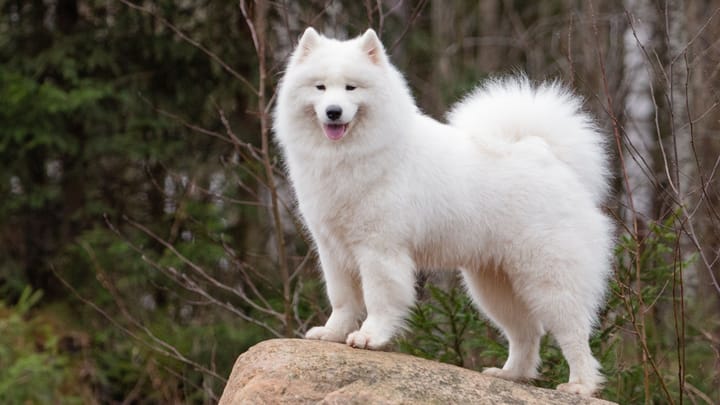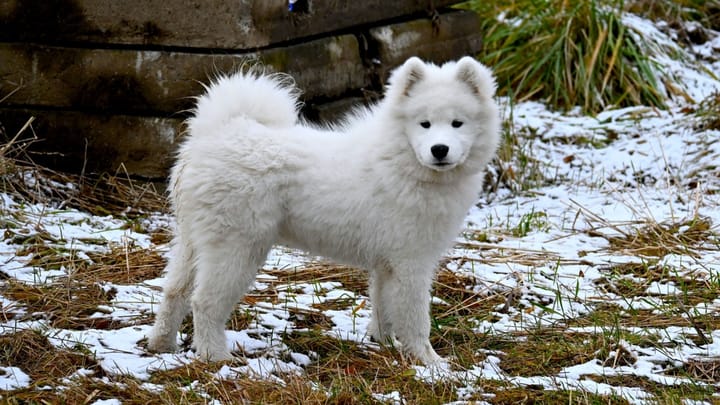Samoyed
Other name: Samoiedskaïa Sabaka


The Samoyed is a very majestic-looking, nordic dog. Its thick white fur and friendly personality makes it loved by many. Naturally independent but still affectionate, particularly with children, this white dog makes the perfect pet for the whole family. Initially bred as a sled dog, the Samoyed needs regular physical activity to be happy. Experienced and active owners are best-suited to this nordic pup.
|
Life expectancy |
The Samoyed has a life expectancy of between 10 and 12 years |
|
Temperament |
|
|
Size |
Medium
|
|
Adult size |
Female
Between 18 and 20 in
Male
Between 20 and 22 in
|
|
Adult weight |
Female
Between 33 and 49 lb
Male
Between 44 and 66 lb
|
|
Coat colour
The coat can be completely white, white biscuit or cream. |
White |
|
Type of coat
The fur is long. The outer coat is long, straight and coarse, while the undercoat is short, soft and dense. Both of these create a thick and abundant fleece-like fur. Females’ fur is slightly shorter and softer than males’. |
Long |
|
Eye colour
The eyes are dark brown. |
Brown
|
|
Purchase price |
The Samoyed costs between £780 and £900 |
Along with its undeniable friendliness and charm, this nordic dog can actually smile, delighting both young and old. This is due to the shape of its mouth, which slightly bends upwards towards his cheeks, giving him the well-known “Samoyed smile”.
More details about the Samoyed
Samoyed: Origins and history
The Samoyed’s origins stem from Nordic countries, a trait shared with other sled dogs as well. Its name originates from the Samoyed tribe, which bred this dog in the far North. However, the dogs they bred were not white, but instead predominantly black. The Samoyed’s white fur was selected for in modern breeding practices, which began in the United States and England, from both the “bear” and “wolf” varieties created by the tribe. The breed was first thought to have come from England, however, we now know that it is linked to North Russia and Siberia, under the Nordic Kennel Union (NKU).
Physical characteristics of the Samoyed
Samoyeds are an elegant, strong and resilient dog. They are proud, robust, and assertive. There are notable differences between the males and females of the breed.
Samoyed: Characteristics
Samoyed: Behaviour
Training a Samoyed
In general, training nordic dogs is no easy feat. Their independence and stubbornness doesn’t leave much room for spontaneous cooperation.
However, this white dog can cooperate if its owner is consistent, patient, and trustworthy.
Samoyed dogs must be trained at a very young age to avoid picking up bad habits.
You should train your dog using positive reinforcement. Never get aggressive, or you may scare your Samoyed to the point where training will no longer be possible.
Samoyed: Lifestyle
Breed compatibility Samoyed
Samoyed: Purchase price
The price of a Samoyed varies depending on his origins, age and sex. You should budget around £895 for a dog registered with the KC.
You should also set aside around £50 a month to meet the needs of this majestic creature, including a premium diet and regular grooming.
Samoyed: Shedding
Heavy !
This dog loses a significant amount of hair, notably during the annual shedding periods. During these times, the loose hair will have to be removed daily.
Samoyed: Grooming
Grooming will require rigor, patience and regularity in order to maintain the beauty and quality of the Samoyed’s impressive coat.
While grooming can sometimes be tedious, a Samoyed needs to be brushed on a daily basis during moulting periods (once a year for males, twice for females). For the rest of the year, a weekly brush will suffice.
If regularly exposed to snow, special attention will have to be paid to its paws (applying vaseline before an outing, wearing boots in case of an injury, etc).
Samoyed: Health
Its lifespan is around 11 years.
This dog is very robust, mainly thanks to its thick double coat that protects it very well. Samoyeds also have a relatively long life expectancy and rarely fall ill.
While this nordic dog is very well suited to a European climate, it is still best adapted to the cold, only tolerating the heat to a very limited extent.
Samoyeds can remain comfortable even in very cold temperatures, thanks to their incredible coat.
If properly exercised on a daily basis, this athletic dog will easily stay in shape. However, it’s still important to monitor dogs who don’t have an optimal diet or physical condition.
- Hip dislocation
- Overheating
- Atrophy of the retina
- Cortical cerebellar abiotrophy (destruction of cells in the cerebellum)
- Skin disorders
- Kidney failure
- Spongiform leucoencephalomyalopathy (neurodegenerative disorder)
- Myasthenia gravis (autoimmune disease resulting in muscle deterioration)
- Diabetes




